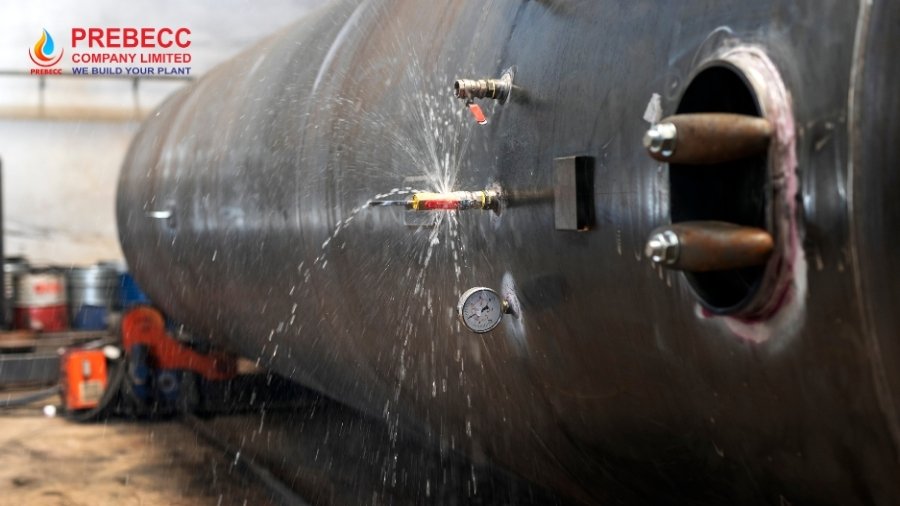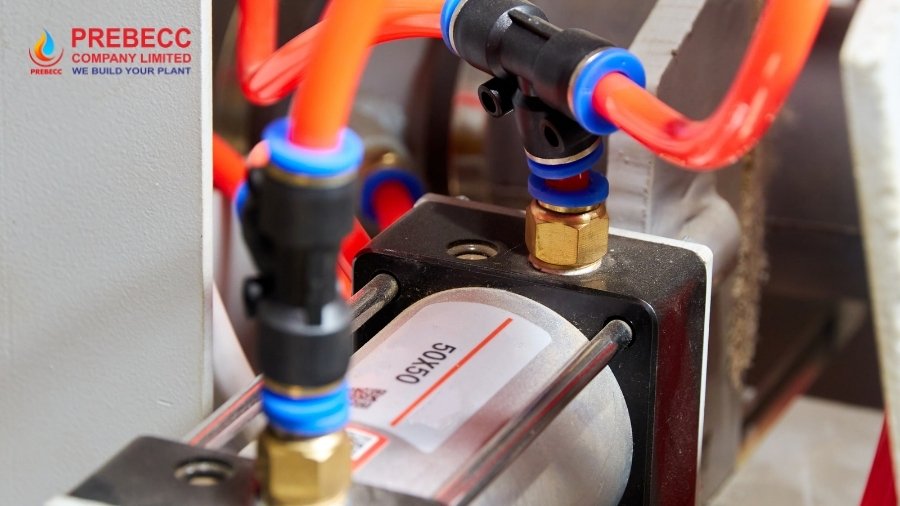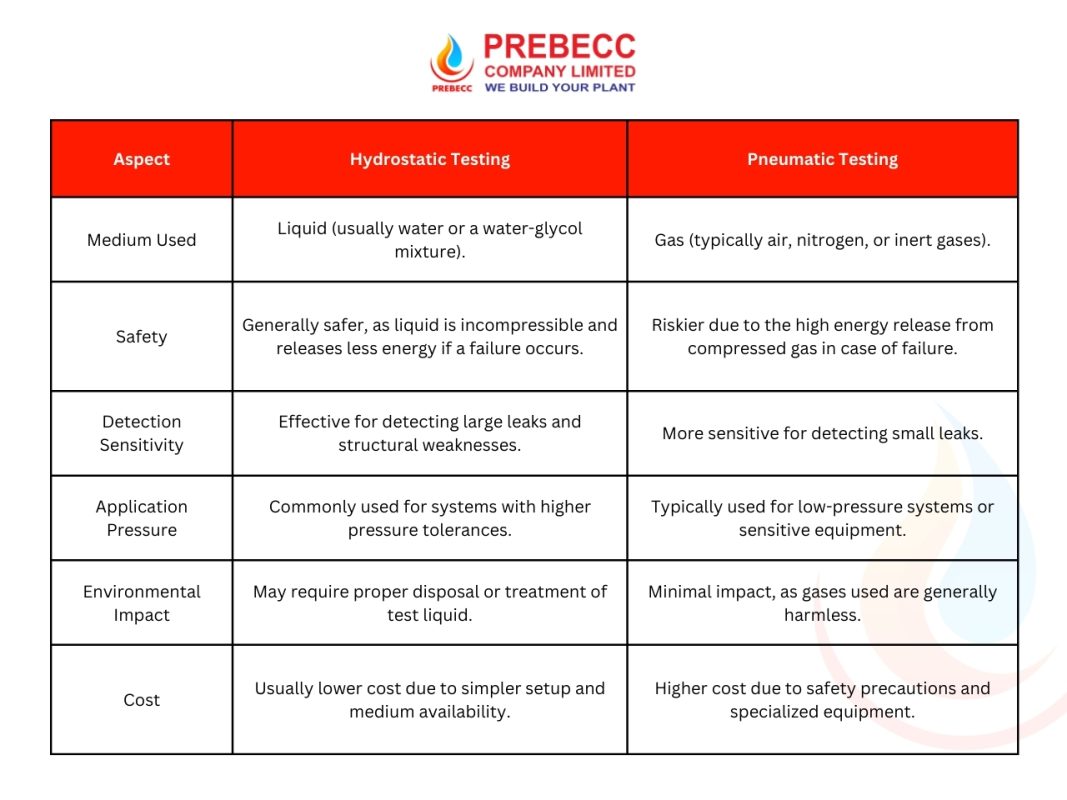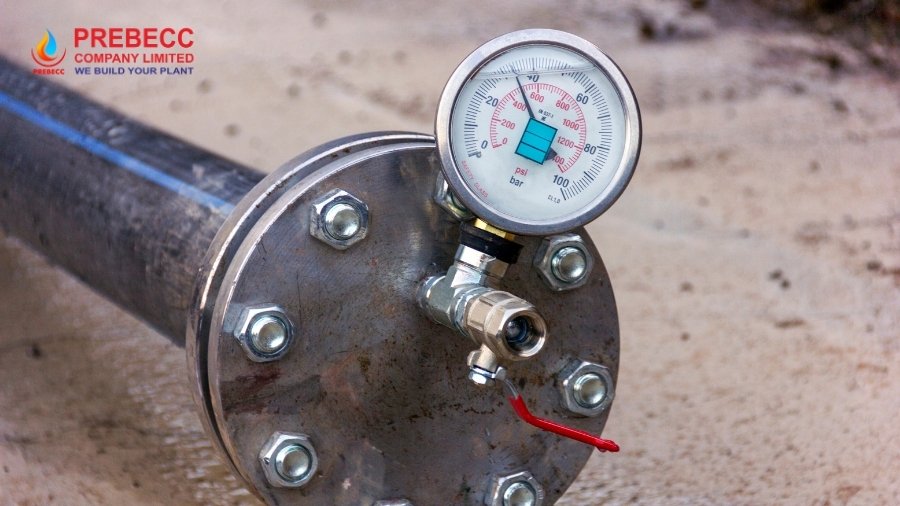In industrial applications, ensuring the quality and safety of pressure-containing equipment and structures is critical. Hydrostatic and pneumatic testing are indispensable methods for assessing durability, detecting leaks, and identifying potential defects. Each method has unique advantages and is suited to specific inspection purposes, from detecting minor leaks to evaluating the structural integrity of large systems.
Understanding the differences between these methods helps engineers, contractors, and operators select the most appropriate one, optimizing costs and improving inspection efficiency. Let’s explore each method in detail and compare their differences.
1. Overview of Hydrostatic Test and Pneumatic Test
Both hydrostatic and pneumatic testing are used to evaluate the pressure-holding capacity of various structures, from small equipment such as gas cylinders to complex systems like pipelines or pressure vessels in heavy industries. These methods help identify potential weaknesses during the inspection phase, preventing severe incidents during operation. Both play an essential role in maintaining the quality, safety, and stability of equipment, ensuring compliance with technical and safety standards.
1.1. What is Hydrostatic Testing?
Hydrostatic testing is a method used to evaluate the strength and pressure resistance of materials or equipment by applying liquid pressure, usually water, to the surface or structure under examination. The primary objective is to determine the equipment’s ability to withstand pressure, detect cracks, leaks, or other potential failures that could impact safety and performance during real-world operation.

How Hydrostatic Testing works?
The process begins by filling the device or structure, such as a pressure vessel or pipeline, with a liquid—typically water. The pressure is gradually increased to the required level. During the test, specialists monitor for deformation or leakage. If signs of leakage or structural changes are detected, the test is halted for further evaluation and remediation.
A key feature of this method is that water, being incompressible, transmits the applied pressure uniformly across the material’s surface, making it easier to identify significant defects. For equipment requiring high-pressure testing, hydrostatic testing ensures that components can withstand maximum operational pressure without catastrophic failure.
Applications of Hydrostatic Testing
Hydrostatic testing is widely applied across numerous industries, including:
- Oil and Gas Industry: Used to test pipelines, storage tanks, and pressure vessels involved in oil and gas extraction and transportation. Ensuring these systems are free of leaks or deformations under pressure prevents accidents and failures.
- Construction and Mechanical Engineering: Ensures the integrity of concrete structures, bridges, towers, and other pressure-bearing constructions. It is a crucial safety measure to prevent cracking or failure under environmental and load-induced stress.
- Industrial Equipment Manufacturing: Ensures the safety of pressure equipment like gas cylinders, chemical storage tanks, and other storage systems under operational pressure.
1.2. What is Pneumatic Testing?
Pneumatic testing is a method used to evaluate the airtightness and pressure-holding capacity of equipment or structures by using compressed gas, typically a colorless gas such as air, to create pressure. This method is instrumental in detecting leaks or potential issues in pneumatic systems, pipelines, pressure vessels, and related equipment.
Pneumatic testing is commonly employed in industries that demand high precision in airtightness and the performance of pressure-based equipment, such as gas systems, automotive manufacturing, and refrigeration systems.

How Pneumatic Testing works?
Pneumatic testing operates by injecting compressed gas into the equipment under examination and maintaining the pressure for a specified duration. As the gas is introduced, the internal pressure rises, and specialists monitor for abnormalities, particularly leaks, using methods like soap bubbles, foam powder, or gas sensors. If leaks are present, the escaping gas can be detected through the formation of bubbles or changes in system pressure.
One significant advantage of pneumatic testing is its ability to identify extremely small leaks, even in hard-to-reach areas. This makes it an effective tool for ensuring systems maintain performance and prevent accidents caused by gas leakage.
Applications of Pneumatic Testing
Pneumatic testing has widespread applications across various industries, especially those requiring high levels of accuracy and safety. Common applications include:
- Automotive Industry: Pneumatic testing is used to inspect components such as brake systems, cooling systems, and other gas-related parts. This ensures these components function effectively without gas leaks, which is critical to vehicle performance.
- Gas and Oil Industry: Pneumatic testing plays a vital role in gas and oil sectors to inspect pipelines and gas-containing equipment. Ensuring these systems are free from leaks is essential for safety and operational stability.
- Manufacturing and Equipment Production: Equipment such as air compressors, gas storage tanks, and gas control valves undergo pneumatic testing to ensure efficiency and eliminate gas leaks, reducing operational and maintenance costs.
2. So sánh chi tiết giữa kiểm tra thủy tĩnh và kiểm tra khí nén
Both hydrostatic and pneumatic testing serve the same purpose: verifying the pressure-handling capability of equipment. However, they differ significantly in terms of methodology, applications, and safety considerations. Here’s a comparison of key aspects:

Both hydrostatic and pneumatic testing offer unique advantages and have specific limitations. Choosing the appropriate method depends on the type of equipment, the testing purpose, and safety requirements. Hydrostatic testing is generally used for larger equipment or systems requiring high-pressure tolerance, while pneumatic testing is more suitable for smaller equipment and precise leak detection. A thorough understanding of the application and execution of these methods is crucial to achieving optimal results.
3. Advantages and Disadvantages of Hydrostatic and Pneumatic Testing
3.1. Hydrostatic Testing
Advantages
- High safety: Since water is incompressible, any leakage or rupture releases minimal energy, reducing the risk of accidents.
- Low cost: Water is a common, inexpensive medium that is easy to handle post-testing.
- Accurate leak detection: Leaks are easy to identify through pressure changes or visible signs, such as water escaping from cracks or gaps.
- Versatility: Suitable for most equipment, especially large devices, without the need for high aerodynamic precision.
Disadvantages
- Unsuitable for water-sensitive equipment: Certain materials or structures cannot tolerate water due to risks like corrosion or liquid retention.
- Time-consuming: Equipment must be thoroughly dried after testing, particularly critical for systems handling volatile gases or liquids.
- Limited to instantaneous pressure assessment: Does not reveal long-term durability issues such as material fatigue.

3.2. Pneumatic Testing
Advantages
- Ideal for water-sensitive equipment: Eliminates the risk of corrosion and maintains dry or clean conditions, which are crucial for certain devices.
- Faster process: No drying phase is required, reducing overall testing time.
- Realistic operational assessment: Simulates real-world conditions better, particularly for gas systems.
Disadvantages
- Higher risk: Compressed gases store significant energy, and any rupture or major leakage can release this energy explosively, posing a greater hazard.
- Higher cost: Requires high-quality compressed or inert gases, leading to increased operational expenses.
- Difficult to detect small leaks: Tiny gas leaks may be harder to identify without specialized equipment.
